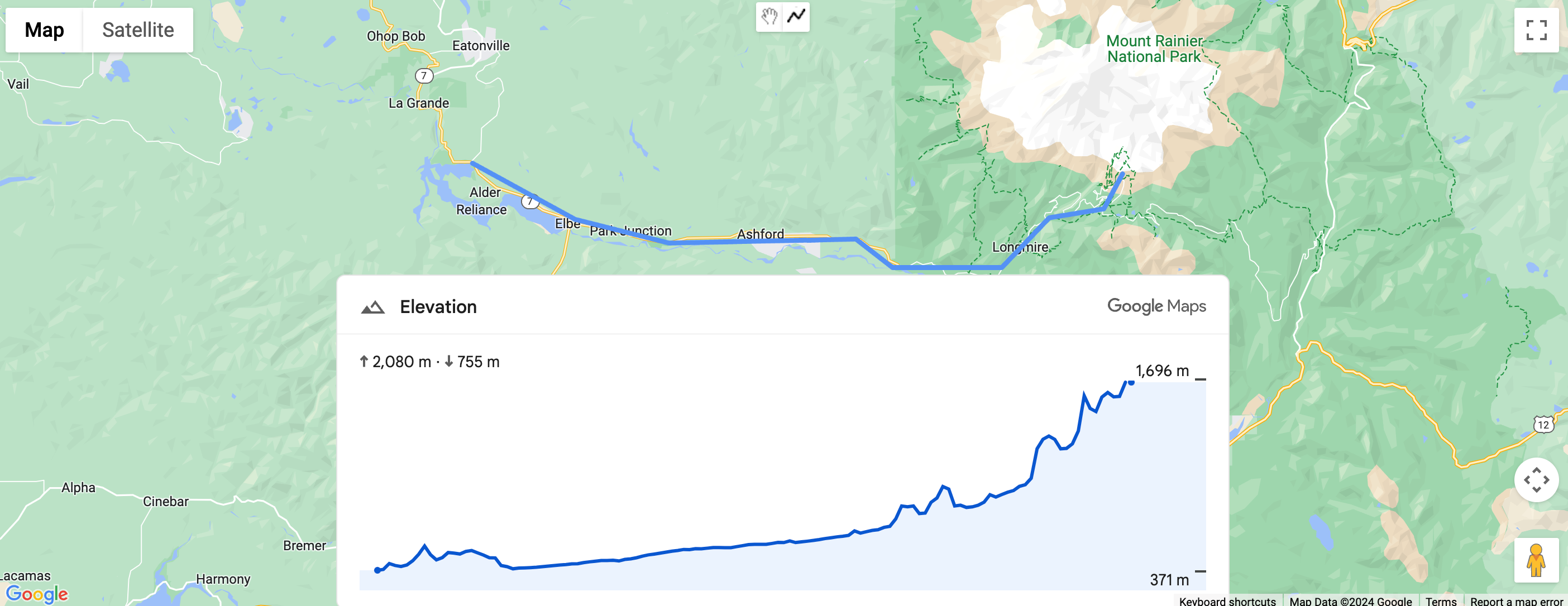
ElevationElement to element HTML, który wizualnie wyświetla dane o wysokości dla pojedynczego punktu lub polilinii. Wyświetla wykres wysokości wzdłuż ścieżki ustawionej we właściwości
path z tablicą współrzędnych określających szerokość i długość geograficzną. Odcinki są interpolowane między punktami tablicy, więc nawet niewielka liczba punktów wystarczy do wygenerowania szczegółowego wykresu wysokości.
Ustawianie wysokości ścieżki za pomocą współrzędnych
Poniższy przykład renderuje wysokość ścieżki między 2 punktami wybranymi przez zestaw współrzędnych za pomocą elementu gmp-elevation.
Element jest skonfigurowany do pomiaru w jednostkach metrycznych za pomocą atrybutu
unit-system:
<gmp-elevation unit-system="metric"></gmp-elevation>
Symbol querySelector służy do wybierania elementu wysokości i ustawiania jego właściwości path za pomocą współrzędnych geograficznych:
/** Maps JS loaded callback */ async function init() { // Load the Elevation Element from Maps JS const {ElevationElement} = await google.maps.importLibrary('elevation'); // Specify an elevation path to render const elevationElement = document.querySelector('gmp-elevation'); elevationElement.path = [ {lat: 37.4523, lng: -122.2645}, {lat: 37.377, lng: -122.4078}, ]; }
Zobacz pełny przykład kodu
JavaScript
/** Maps JS loaded callback */ async function init() { // Load the Elevation Element from Maps JS const {ElevationElement} = await google.maps.importLibrary('elevation'); // Specify an elevation path to render const elevationElement = document.querySelector('gmp-elevation'); elevationElement.path = [ {lat: 37.4523, lng: -122.2645}, {lat: 37.377, lng: -122.4078}, ]; } init();
CSS
html, body { margin: 0; padding: 0; } gmp-elevation { width: 100%; height: 100%; } .overlay { margin: 20px; width: 400px; }
HTML
<!DOCTYPE html>
<html>
<head>
<title>Simple Elevation</title>
<meta charset="utf-8">
<link rel="stylesheet" type="text/css" href="style.css">
</head>
<body>
<h1>Path elevation</h1>
<div class="overlay">
<gmp-elevation unit-system="metric"></gmp-elevation>
</div>
<script>
(g=>{var h,a,k,p="The Google Maps JavaScript API",c="google",l="importLibrary",q="__ib__",m=document,b=window;b=b[c]||(b[c]={});var d=b.maps||(b.maps={}),r=new Set,e=new URLSearchParams,u=()=>h||(h=new Promise(async(f,n)=>{await (a=m.createElement("script"));e.set("libraries",[...r]+"");for(k in g)e.set(k.replace(/[A-Z]/g,t=>"_"+t[0].toLowerCase()),g[k]);e.set("callback",c+".maps."+q);a.src=`https://maps.${c}apis.com/maps/api/js?`+e;d[q]=f;a.onerror=()=>h=n(Error(p+" could not load."));a.nonce=m.querySelector("script[nonce]")?.nonce||"";m.head.append(a)}));d[l]?console.warn(p+" only loads once. Ignoring:",g):d[l]=(f,...n)=>r.add(f)&&u().then(()=>d[l](f,...n))})({
key: "YOUR_API_KEY",
v: "alpha"
});
</script>
</body>
</html>Ustawianie wysokości ścieżki za pomocą linii łamanej
W tym przykładzie wysokość ścieżki jest renderowana na podstawie polilinii narysowanej przez użytkownika. Pobiera
path z linii łamanej użytkownika za pomocą metody polyline.getPath().getArray():
elevationElem.path = polyline.getPath().getArray();
Zobacz pełny przykład kodu
JavaScript
const map = document.querySelector('gmp-map'); const elevationElem = document.querySelector('gmp-elevation'); async function init() { await google.maps.importLibrary('places'); await google.maps.importLibrary('marker'); await google.maps.importLibrary('elevation'); map.innerMap.setOptions({'mapTypeControl': true, 'clickableIcons': false}); findCurrentLocation(); drawPolyline(); } async function drawPolyline() { const {DrawingManager} = await google.maps.importLibrary('drawing'); const drawingManager = new DrawingManager({ drawingMode: google.maps.drawing.OverlayType.POLYLINE, drawingControl: true, drawingControlOptions: { position: google.maps.ControlPosition.TOP_CENTER, drawingModes: [google.maps.drawing.OverlayType.POLYLINE] }, polylineOptions: {geodesic: true, strokeColor: '#5491f5', strokeWeight: 6} }); drawingManager.setMap(map.innerMap); drawingManager.addListener('polylinecomplete', (polyline) => { console.log('complete'); console.log(polyline.getPath().getArray()); elevationElem.path = polyline.getPath().getArray(); polyline.addListener('click', (e) => { console.log(e); }); }); } async function findCurrentLocation() { const {LatLng} = await google.maps.importLibrary('core'); if (navigator.geolocation) { navigator.geolocation.getCurrentPosition( (position) => { const pos = new LatLng(position.coords.latitude, position.coords.longitude); map.innerMap.panTo(pos); map.innerMap.setZoom(16); }, () => { console.log('The Geolocation service failed.'); map.innerMap.setZoom(16); }, ); } else { console.log(`Your browser doesn't support geolocation`); map.innerMap.setZoom(16); } } init();
CSS
html, body { height: 100%; margin: 0; } body { display: flex; flex-direction: column; font-family: Arial, Helvetica, sans-serif; } h1 { font-size: 16px; text-align: center; } gmp-map { box-sizing: border-box; margin-top: 20px; width: 100%; height: 100%; } gmp-elevation { width: 100%; height: 300px; } .overlay { width: 800px; }
HTML
<!DOCTYPE html>
<html>
<head>
<title>Path Elevation</title>
<meta charset="utf-8">
<link rel="stylesheet" type="text/css" href="style.css">
</head>
<body>
<h1>Draw polyline and get path elevation</h1>
<gmp-map center="-37.813,144.963" zoom="12" map-id="DEMO_MAP_ID">
<div id="elevation-container" class="overlay" slot="control-block-end-inline-center">
<gmp-elevation unit-system="metric"></gmp-elevation>
</div>
</gmp-map>
<script>
(g=>{var h,a,k,p="The Google Maps JavaScript API",c="google",l="importLibrary",q="__ib__",m=document,b=window;b=b[c]||(b[c]={});var d=b.maps||(b.maps={}),r=new Set,e=new URLSearchParams,u=()=>h||(h=new Promise(async(f,n)=>{await (a=m.createElement("script"));e.set("libraries",[...r]+"");for(k in g)e.set(k.replace(/[A-Z]/g,t=>"_"+t[0].toLowerCase()),g[k]);e.set("callback",c+".maps."+q);a.src=`https://maps.${c}apis.com/maps/api/js?`+e;d[q]=f;a.onerror=()=>h=n(Error(p+" could not load."));a.nonce=m.querySelector("script[nonce]")?.nonce||"";m.head.append(a)}));d[l]?console.warn(p+" only loads once. Ignoring:",g):d[l]=(f,...n)=>r.add(f)&&u().then(()=>d[l](f,...n))})({
key: "YOUR_API_KEY",
v: "alpha"
});
</script>
</body>
</html>
